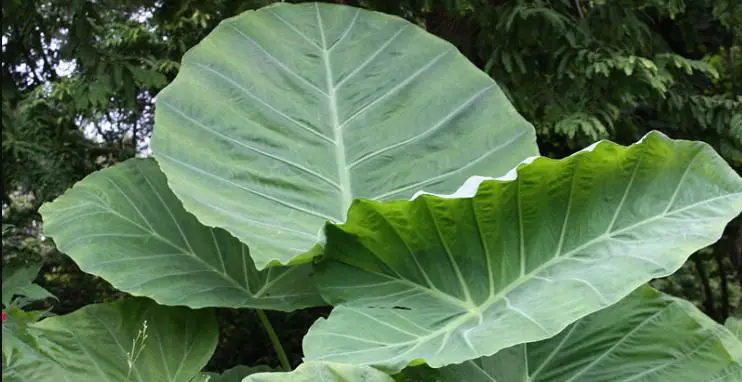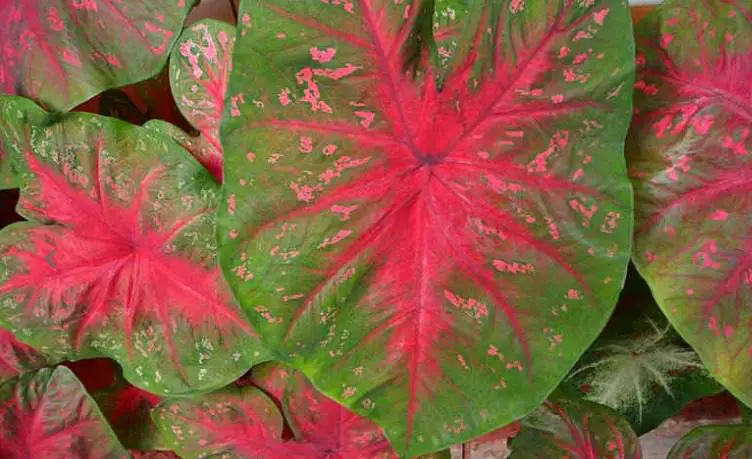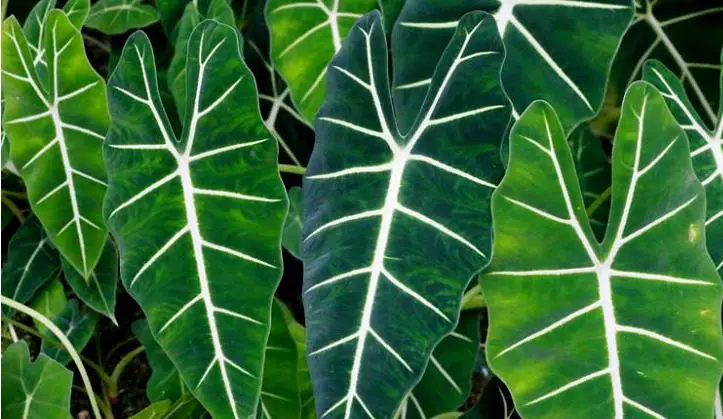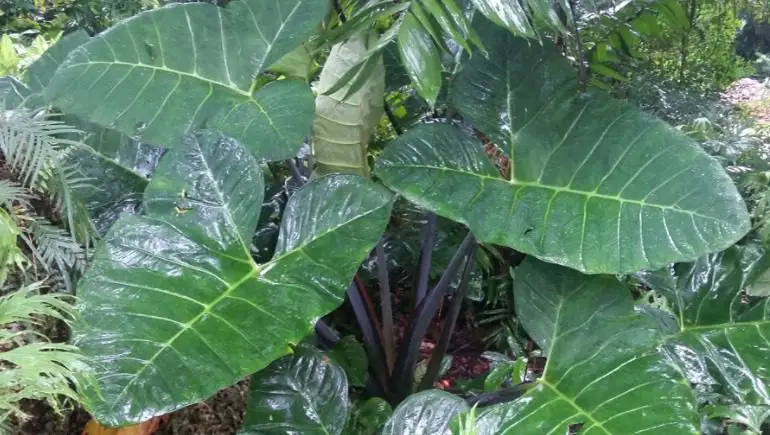Elephant ear plants are one of the most popular houseplants in the world. They come in a wide range of colors and shapes, but they all have one thing in common: they’re big! Read on to learn about these fascinating plants…
The 4 Species of Elephant Ear Plant
The four species of elephant ear plants are:
- Colocasia
- Caladium
- Alocasia
- Xanthosoma
I will now give an overview of each type of elephant ear and why they are popular. I start with my favorite and then go through the others in a particular order.
1. Colocasia
The first species of elephant ear plant is the Colocasia. It has large, dark green leaves that form a clump at ground level. The colors range from light to dark green with purple veins and stem on top of pinkish petioles (the part of the leaf stem).
The plant is thought to originate from Southeast Asia and is also called taro. However, it can be grown in almost any climate zone if you provide care for the plant. Just make sure to keep it in warm conditions, so move the plant inside during winter if it gets cold in your climate.
It was first grown for its edible tubers but now is mostly grown as an ornamental plant. The taro root can be boiled or fried and tastes similar to potatoes.

2. Caladium
The second species of elephant ear plant is the Caladium. It has large, arrow-shaped leaves that come in a range of colors, including white, pink, red, and green. They typically have a dark vein running down the center of each leaf.
Originating from South America, this plant is also called the Angel Wings. It grows well in areas of sunlight but should be kept out of the direct sun because the leaves are delicate.
The leaves of the Caladium are often used for floral arrangements and make a beautiful addition to any garden.

3. Alocasia
The third species of elephant ear plant is the Alocasia. It has large, dark green leaves with a pointy tip and a deep furrow running down the center. The colors range from light to dark green with purple veins and stem on top of pinkish petioles (the part of the leaf stem).
Native to Australia and Asia, this plant loves warm, humid conditions. It grows well in sunny areas but should be kept away from direct sunlight to prevent scorching of its leaves.
The Alocasia is popular because it can grow into a large plant that adds texture to any garden or indoor space. Since this type of elephant ear plant has very dark green foliage, you can place it near other plants with light green or variegated leaves to create a beautiful contrast.

4. Xanthosoma
The fourth species of elephant ear plant is the Xanthosoma. It has large, arrow-shaped leaves that are green on top and purple underneath. They range in color from light to dark green with veins running down the center like an Alocasia leaf, but they’re much thicker than those of their cousin (Alocasia).
This plant originates from America and is also called the Cocoyam or Tannia. It requires tropical conditions to grow, which means it can’t handle cold weather.
The Xanthosoma plant has edible roots that are cooked like potatoes and taste very similar in texture but sweeter in flavor than a yam. They’re often boiled, roasted, fried, or mashed.

My Favorite Type of Elephant Ear Plant
Out of all the types of elephant ear plants, my favorite is the Colocasia. I love the dark green leaves with their purple veins and stems on top of pinkish petioles (the part of the leaf stem). They’re so big and beautiful!
Do you have a favorite type of elephant ear plant? Let me know in the comments below.
Growing All Elephant Ear Plant Types
Now that I’ve given you a general overview of each type of elephant ear plant, it’s time to talk about how they grow and what conditions are best suited for them.
All types of elephant ear plants do well in full sun or partial shade. They prefer moist, but not wet, soil and grow best in USDA zones of 10 and 11. They can be grown outside in warm climates, but they should be brought inside in colder climates.
The plants grow so well that many consider them to be pests! In fact, it can be hard to stop elephant plants from spreading throughout the whole area. That’s why I often recommend for people plant elephant ears in containers that can be moved around as needed.
So, if you’re looking for a big, beautiful, and easy-to-grow houseplant, an elephant ear is a great option! Just make sure to give it plenty of sun or shade and moist soil, and enjoy the show.
Care For the Different Types of Elephant Ear Plants
Most types of elephant ears require the same care. They do best in full sun or partial shade, prefer moist but not wet soil, as well as grow best in USDA zones of 10-11.
I personally recommend watering the soil around the elephant ear plant, not the leaves, which will help prevent any diseases that may occur on the leaves.
All types of elephant ears should be fertilized twice a year with a high-phosphorus fertilizer. Be sure to follow the instructions on the package, as too much phosphorus can be harmful to plants.
Also, be sure to check for any signs of pests or diseases and take action if necessary.
Pests that may attack elephant ear plants include aphids, mealybugs, scale insects, whiteflies, and nematodes. Diseases that may occur include bacterial blight, anthracnose, stem rot, and wilts.
So, as long as you’re vigilant about checking for pests and diseases, your elephant ear plants should thrive!
Conclusion
In summary, there are four types of elephant ear plants: Colocasia, Caladium, Alocasia, and Xanthosoma. Each type has a different look with leaves ranging in color from light to dark green. My favorite type is the Colocasia for its large, dark green leaves with purple veins and stems on top of pinkish petioles (the part of the leaf stem).
I have written many articles about these unique plants, so please do a search on my blog to find any specific information you want you to know about.
Tim is an avid gardener from the UK. He was the founder of PlantCarer.com from 2021 to Sep 2023. He sold PlantCarer.com to Aaron. He has since started his own business called Seed To Supper, which provides new gardeners all the materials you need in a box (pots, seeds, compost and instructions) to grow your own delicious and nutritious vegetables and herbs from start to finish – no garden required.









0 Comments